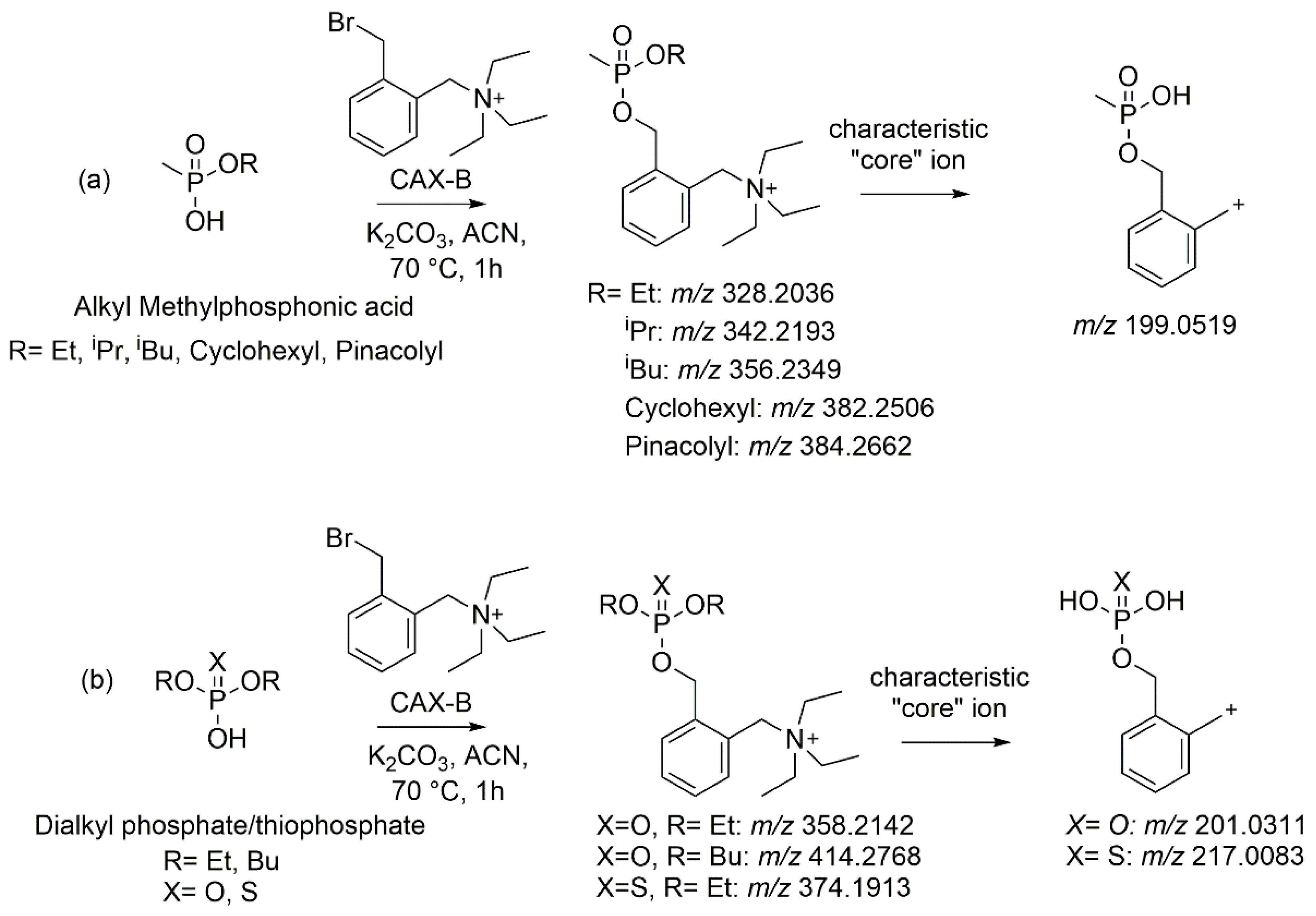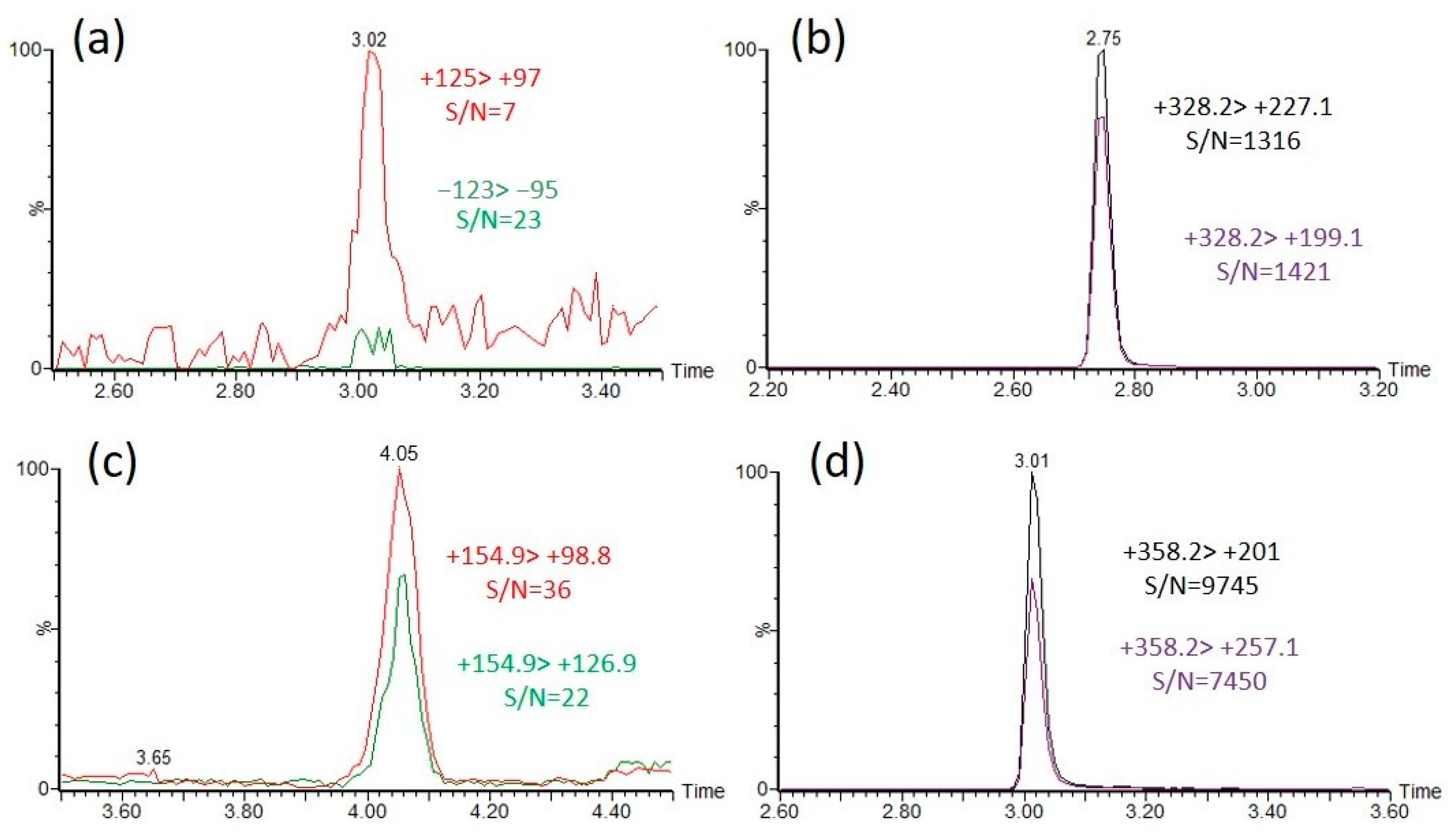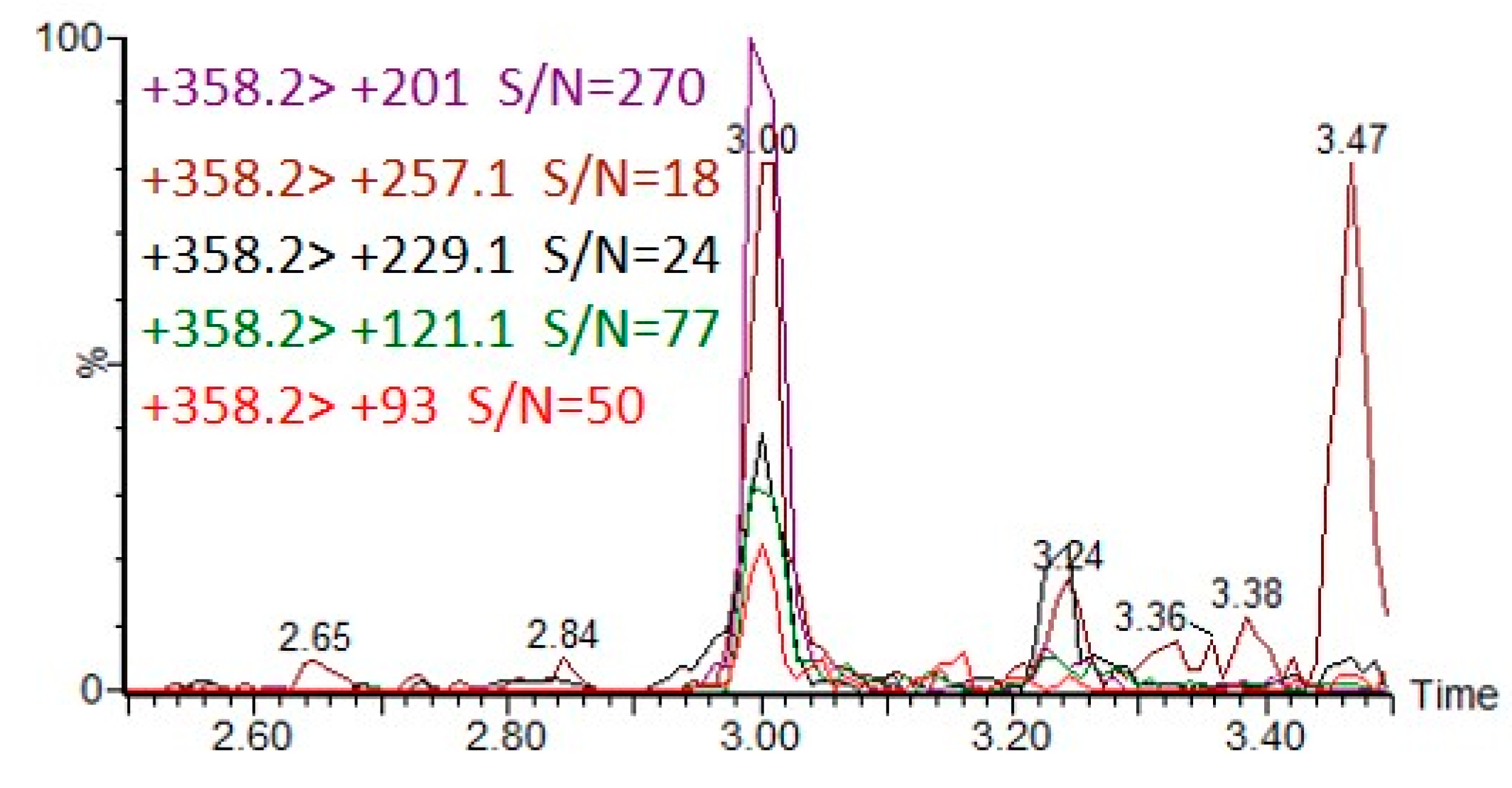Enhanced LC-ESI-MS/MS Sensitivity by Cationic Derivatization of Organophosphorus Acids
Abstract
:1. Introduction
2. Results and Discussion
2.1. Derivatizing Agent Design
2.2. Optimization of the Reaction between the OP Acids and CAX-B
2.3. Structurally Informative High Resolution-MS/MS of Targeted OP Acids after Derivatization
2.3.1. OP Acids Related to Nerve Agents (AMPAs)
2.3.2. OP Acids Related to Pesticides
2.4. Sensitivity Enhancement after Derivatization with CAX-B Using a QqQ Instrument
2.5. Method Evaluation
2.6. Application in Real-World Matrices
3. Materials and Methods
3.1. Chemicals and Reagents
3.2. Sample Preparation
3.2.1. Derivatization Procedure
3.2.2. Spiking of Environmental Matrices Extracts
3.3. Instrumentation
3.3.1. HPLC Method
3.3.2. LC-QqQ/MS/MS (MRM) Analysis
LC-ESI-MS/MS Analysis of the Intact OP Acids
LC-ESI-MS/MS Analysis of CAX-B Derivatives
3.3.3. LC-MS (Orbitrap Mass Spectrometry)
3.4. Comparison of the Sensitivity of the Intact OP Acids and CAX-OP Acids after Derivatization
4. Conclusions
Supplementary Materials
Author Contributions
Funding
Institutional Review Board Statement
Informed Consent Statement
Data Availability Statement
Acknowledgments
Conflicts of Interest
Sample Availability
References
- Munro, N.B.; Talmage, S.S.; Griffin, G.D.; Waters, L.C.; Watson, A.P.; King, J.F.; Hauschild, V. The sources, fate, and toxicity of chemical warfare agent degradation products. Environ. Health Perspect. 1999, 107, 933–974. [Google Scholar] [CrossRef] [PubMed]
- Roberts, D.M.; Aaron, C.K. Management of acute organophosphorus pesticide poisoning. BMJ 2007, 334, 629–634. [Google Scholar] [CrossRef] [PubMed]
- USEPA (US Environmental Protection Agency), Office of Prevention, Pesticides and Toxic Substances, Environmental Fate and Effect Division (EFED). Reregistration Eligibility Decision (RED) for Dicrotophos; USEPA: Washington, DC, USA, 2006. Available online: https://archive.epa.gov/pesticides/reregistration/web/pdf/dicrotophos_red.pdf (accessed on 2 May 2023).
- USEPA (US Environmental Protection Agency), Office of Prevention, Pesticides and Toxic Substances, Environmental Fate and Effect Division (EFED). Reregistration Eligibility Decision (RED) Environmental Risk Assessment for Profenofos; USEPA: Washington, DC, USA, 1998. Available online: https://archive.epa.gov/pesticides/chemicalsearch/chemical/foia/web/pdf/111401/111401-052.pdf (accessed on 2 May 2023).
- Reemtsma, T.; Lingott, J.; Roegler, S. Determination of 14 monoalkyl phosphates, dialkyl phosphates and dialkyl thiophosphates by LC-MS/MS in human urinary samples. Sci. Total Environ. 2011, 409, 1990–1993. [Google Scholar] [CrossRef] [PubMed]
- Subramaniam, R.; Åstot, C.; Nilsson, C.; Östin, A. Combination of solid phase extraction and in vial solid phase derivatization using a strong anion exchange disk for the determination of nerve agent markers. J. Chromatogr. A 2009, 1216, 8452–8459. [Google Scholar] [CrossRef] [PubMed]
- Fredriksson, S.-Å.; Hammarström, L.-G.; Henriksson, L.; Lakso, H.-Å. Trace determination of alkyl methylphosphonic acids in environmental and biological samples using gas chromatography/negative-ion chemical ionization mass spectrometry and tandem mass spectrometry. J. Mass Spectrom. 1995, 30, 1133–1143. [Google Scholar] [CrossRef]
- Driskell, W.J.; Shih, M.; Needham, L.L.; Barr, D.B. Quantitation of organophosphorus nerve agent metabolites in human urine using isotope dilution gas chromatography-tandem mass spectrometry. J. Anal. Toxicol. 2002, 26, 6–10. [Google Scholar] [CrossRef]
- Subramanian, A.; Rosales, J.A.; Leif, R.N.; Valdez, C.A. Benzyl trichloroacetimidates as derivatizing agents for phosphonic acids related to nerve agents by EI-GC-MS during OPCW proficiency test scenarios. Sci. Rep. 2022, 12, 21299. [Google Scholar] [CrossRef]
- Black, R.M.; Read, R.W. Application of liquid chromatography-atmospheric pressure chemical ionisation mass spectrometry, and tandem mass spectrometry, to the analysis and identification of degradation products of chemical warfare agents. J. Chromatogr. A 1997, 759, 79–92. [Google Scholar] [CrossRef]
- Black, R.M.; Read, R.W. Analysis of degradation products of organophosphorus chemical warfare agents and related compounds by liquid chromatography–mass spectrometry using electrospray and atmospheric pressure chemical ionisation. J. Chromatogr. A 1998, 794, 233–244. [Google Scholar] [CrossRef]
- Draper, W.M.; Behniwal, P.; Wijekoon, D. Direct determination of dialkyl phosphates by strong anion-exchange liquid chromatography/atmospheric pressure chemical ionization mass spectrometry using a quadrupole ion trap instrument. Rapid Commun. Mass Spectrom. 2008, 22, 2613–2620. [Google Scholar] [CrossRef]
- Tak, V.; Purohit, A.; Pardasani, D.; Goud, D.R.; Jain, R.; Dubey, D.K. Simultaneous detection and identification of precursors, degradation and co-products of chemical warfare agents in drinking water by ultra-high performance liquid chromatography-quadrupole time-of-flight mass spectrometry. J. Chromatogr. A 2014, 1370, 80–92. [Google Scholar] [CrossRef] [PubMed]
- Armstrong, J.L.; Dills, R.L.; Yu, J.; Yost, M.G.; Fenske, R.A. A sensitive LC-MS/MS method for measurement of organophosphorus pesticides and their oxygen analogs in air sampling matrices. J. Environ. Sci. Health Part B 2014, 49, 102–108. [Google Scholar] [CrossRef] [PubMed]
- Hou, R.; Liu, C.; Gao, X.; Xu, Y.; Zha, J.; Wang, Z. Accumulation and distribution of organophosphate flame retardants (PFRs) and their di-alkyl phosphates (DAPs) metabolites in different freshwater fish from locations around Beijing, China. Environ. Pollut. 2017, 229, 548–556. [Google Scholar] [CrossRef]
- Tak, V.; Purhoit, A.; Pardasani, D.; Garg, P.; Jain, R.; Dubey, D.K. Determination of alkyl alkylphosphonic acids by liquid chromatography coupled with electrospray ionization tandem mass spectrometry using a dicationic reagent. Rapid Commun. Mass Spectrom. 2012, 26, 2637–2648. [Google Scholar] [CrossRef]
- Tak, V.; Pardasani, D.; Purohit, A.; Dubey, D.K. Detection and identification of alkylphosphonic acids by positive electrospray ionization tandem mass spectrometry using a tricationic reagent. Rapid Commun. Mass Spectrom. 2011, 25, 3411–3416. [Google Scholar] [CrossRef] [PubMed]
- Chu, S.; Chen, D.; Letcher, R.J. Dicationic ion-pairing of phosphoric acid diesters post-liquid chromatography and subsequent determination by electrospray positive ionization-tandem mass spectrometry. J. Chromatogr. A 2011, 1218, 8083–8088. [Google Scholar] [CrossRef]
- Katagi, M.; Tatsuno, M.; Nishikawa, M.; Tsuchihashi, H. On-line solid-phase extraction liquid chromatography-continuous flow frit fast atom bombardment mass spectrometric and tandem mass spectrometric determination of hydrolysis products of nerve agents alkyl methylphosphonic acids by p-bromophenacyl derivatization. J. Chromatogr. A 1999, 833, 169–179. [Google Scholar] [CrossRef] [PubMed]
- Weissberg, A.; Madmon, M.; Dagan, S. Determination of organophosphorus acids by liquid chromatography positive electrospray ionization tandem mass spectrometry after chemical derivatization. Int. J. Mass Spectrom. 2016, 408, 20–27. [Google Scholar] [CrossRef]
- Mawhinney, D.B.; Stanelle, R.D.; Hamelin, E.I.; Kobelski, R.J. Enhancing the response of alkyl methylphosphonic acids in negative electrospray ionization liquid chromatography tandem mass spectrometry by post-column addition of organic solvents. J. Am. Soc. Mass Spectrom. 2007, 18, 1821–1826. [Google Scholar] [CrossRef]
- Chu, S.; Letcher, R.J. A mixed-mode chromatographic separation method for the analysis of dialkyl phosphates. J. Chromatogr. A 2018, 1535, 63–71. [Google Scholar] [CrossRef]
- Wang, P.; Zhang, Q.; Yao, Y.; Giese, R.W. Cationic Xylene Tag for Increasing Sensitivity in Mass Spectrometry. J. Am. Soc. Mass Spectrom. 2015, 26, 1713–1721. [Google Scholar] [CrossRef]
- Madmon, M.; Shifrovich, A.; Tamar, S.Y.; Weissberg, A. Simple and fast determination of free cyanide in drinking water by liquid chromatography electrospray ionization tandem mass spectrometry following “in vial” derivatization. Int. J. Mass Spectrom. 2021, 463, 116553. [Google Scholar] [CrossRef]
- Palit, M.; Gupta, A.K.; Jain, R.; Raza, S.K. Determination of pentafluorobenzyl derivatives of phosphonic and phosphonothioic acids by gas chromatography-mass spectrometry. J. Chromatogr. A 2004, 1043, 275–284. [Google Scholar] [CrossRef] [PubMed]
- Weissberg, A.; Dagan, S. Interpretation of ESI(+)-MS-MS spectra—Towards the identification of “unknowns”. Int. J. Mass Spectrom. 2011, 299, 158–168. [Google Scholar] [CrossRef]
- Weissberg, A.; Tzanani, N.; Dagan, S. Specificity enhancement by electrospray ionization multistage mass spectrometry—A valuable tool for differentiation and identification of ‘V’-type chemical warfare agents. J. Mass Spectrom. 2013, 48, 1340–1348. [Google Scholar] [CrossRef] [PubMed]
- Schwarzenberg, A.; Ichou, F.; Cole, R.B.; Machuron-Mandard, X.; Junot, C.; Lesage, D.; Tabet, J.C. Identification tree based on fragmentation rules for structure elucidation of organophosphorus esters by electrospray mass spectrometry. J. Mass Spectrom. 2013, 48, 576–586. [Google Scholar] [CrossRef] [PubMed]







| OP-Acid | Formula | Precursor Ion (m/z) | Product Ion | Cone Voltage (V) | Collision Energy (eV) | Intensity Ratio | Retention Time (min) |
|---|---|---|---|---|---|---|---|
| EMPA | C3H9O3P | (−)123.0 (+)125.0 | 95.0 97.0 | 12 | 12 10 | 1 7.5 | 3.0 |
| IBMPA | C5H13O3P | (−)151.1 | 95.0 77.0 | 52 | 14 20 | 5 1 | 5.4 |
| CMPA | C7H15O3P | (−)177.1 | 95.0 79.0 | 12 | 20 32 | 25 1 | 6.3 |
| PMPA | C7H17O3P | (−)179.1 | 95.0 79.0 | 12 | 16 32 | 23 1 | 6.9 |
| DEP | C4H11O4P | (+)155.0 | 127.0 99.0 | 36 | 8 14 | 1 1.5 | 4.0 |
| DBP | C8H19O4P | (+)211.1 | 155.0 99.0 | 22 | 6 10 | 1 3.5 | 7.5 |
| DETP | C4H11O3PS | (+)171.0 | 115.0 143.0 | 26 | 12 8 | 1 1 | 4.8 |
| CAX-OP-Acid | Formula | Precursor Ion (m/z) | Product Ion | Cone Voltage (V) | Collision Energy (eV) | Intensity Ratio | Retention Time (min) |
|---|---|---|---|---|---|---|---|
| CAX-EMPA | C17H30NO3P | (+)328.2 | 227.1 199.1 121.1 103.1 | 12 | 15 20 25 35 | 3 2.5 1 1.5 | 2.7 |
| CAX-IBMPA | C19H34NO3P | (+)356.2 | 199.1 121.1 103.1 | 52 | 20 32 38 | 6 1 1 | 3.2 |
| CAX-CMPA | C21H36NO3P | (+)382.3 | 199.1 121.1 103.1 | 12 | 20 30 40 | 6.5 1 1 | 3.3 |
| CAX-PMPA | C21H38NO3P | (+)384.3 | 199.1 121.1 103.1 | 56 | 22 36 46 | 6 1.5 1 | 3.4 |
| CAX-DEP | C18H33NO4P | (+)358.2 | 257.1 229.1 201.0 121.0 93.0 | 14 | 16 22 26 40 50 | 3 2 4 2 1 | 3.0 |
| CAX-DBP | C22H41NO4P | (+)414.3 | 313.2 257.1 201.0 121.0 93.0 | 60 | 14 18 28 42 56 | 1 1.5 1 3.5 1.5 | 3.7 |
| CAX-DETP | C18H33NO3PS | (+)374.2 | 273.1 217.0 137.0 109.0 91.0 | 20 | 16 28 32 26 48 | 5.5 1 2.5 3.5 2 | 3.2 |
| Full-Scan (“Full MS”) Mode: | |
|---|---|
| Resolution | 70,000 |
| AGC (automatic gain control) target | 1 × 106 |
| maximum IT | 100 ms |
| Scan range | m/z 50–500 |
| DIA (data-independent acquisition) MS2 mode: | |
| Resolution | 35,000 |
| AGC target | 5 × 105 |
| maximum IT | Auto |
| loop count | 3 |
| isolation window | m/z 1.0 |
| NCE (normalized collision energy)/CE | 35 V/20–40 V |
Disclaimer/Publisher’s Note: The statements, opinions and data contained in all publications are solely those of the individual author(s) and contributor(s) and not of MDPI and/or the editor(s). MDPI and/or the editor(s) disclaim responsibility for any injury to people or property resulting from any ideas, methods, instructions or products referred to in the content. |
© 2023 by the authors. Licensee MDPI, Basel, Switzerland. This article is an open access article distributed under the terms and conditions of the Creative Commons Attribution (CC BY) license (https://creativecommons.org/licenses/by/4.0/).
Share and Cite
Shamai Yamin, T.; Madmon, M.; Hindi, A.; Shifrovich, A.; Prihed, H.; Blanca, M.; Weissberg, A. Enhanced LC-ESI-MS/MS Sensitivity by Cationic Derivatization of Organophosphorus Acids. Molecules 2023, 28, 6090. https://doi.org/10.3390/molecules28166090
Shamai Yamin T, Madmon M, Hindi A, Shifrovich A, Prihed H, Blanca M, Weissberg A. Enhanced LC-ESI-MS/MS Sensitivity by Cationic Derivatization of Organophosphorus Acids. Molecules. 2023; 28(16):6090. https://doi.org/10.3390/molecules28166090
Chicago/Turabian StyleShamai Yamin, Tamar, Moran Madmon, Ariel Hindi, Avital Shifrovich, Hagit Prihed, Merav Blanca, and Avi Weissberg. 2023. "Enhanced LC-ESI-MS/MS Sensitivity by Cationic Derivatization of Organophosphorus Acids" Molecules 28, no. 16: 6090. https://doi.org/10.3390/molecules28166090
APA StyleShamai Yamin, T., Madmon, M., Hindi, A., Shifrovich, A., Prihed, H., Blanca, M., & Weissberg, A. (2023). Enhanced LC-ESI-MS/MS Sensitivity by Cationic Derivatization of Organophosphorus Acids. Molecules, 28(16), 6090. https://doi.org/10.3390/molecules28166090







